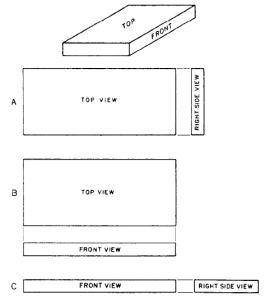It is often the case that a two-view projection is all that is required. The view at the top of figure 5-19 shows a single-view projection of an object.

It is obvious that a top view of this object tells you everything you need to know except the thickness; a right side view tells you everything you need to know except the length; and a front view tells you everything you need to know except the width. All you need to do, then, is to select a particular view and couple it with another view that gives you the dimension that is missing in the first view.
There are three possible two-dimensional projections of the object shown in A, B, and C. In the selection of one of these three, everything else being equal, the balance of the drawing would be the deciding factor. Either A or B appears better balanced than C, and between A and B, A would look better on a long oblong sheet of paper, and B, better on a shorter oblong sheet.
The object shown in figure 5-19 has a definitely designated top and front; it follows that the right and left sides are also definitely designated. This is the case with many objects; you have no choice, for example, with regard to the top, bottom, front, and back of a house.
(Source: NAVEDTRA 14069, U.S. Navy)
